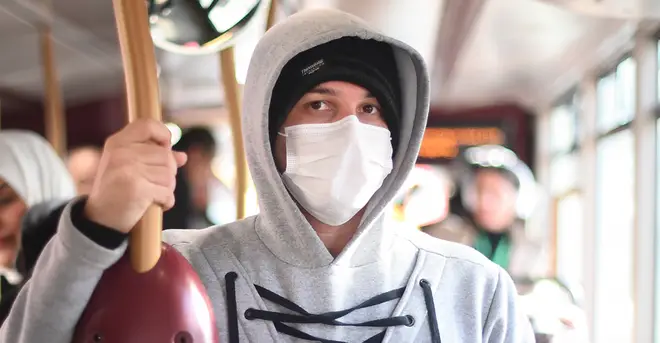
Nick Ferrari 7am - 10am
11 May 2020, 14:47

People in England are being urged to wear face coverings in shops and on public transport as the government announced a relaxation of lockdown rules.
The Government has so far avoided advising the use of face masks or facial coverings and scientists have remained split on their benefits.
The Scottish government advised last week that facial coverings should be used on public transport and in shops.
But Downing Street has now published a new document that marks a change in its position on masks, and the London commuters are now urged to use them.
Here, we take a look at the latest official guidance on whether we should still be wearing them.

Caller asks Matt Hancock why aren't we wearing masks?
The Government has not yet made face masks mandatory, however it is now advising Brits to use them on public transport, at work and while out shopping - where social distancing is not possible.
This is a shift from its original stance which did not urge Brits to use them.
A lengthy document published by Number 10 on Monday says the new advice comes as a result of people returning to work.
“This increased mobility means the Government is now advising that people should aim to wear a face-covering in enclosed spaces where social distancing is not always possible and they come into contact with others that they do not normally meet, for example on public transport or in some shops,” it says.
The fresh guidance adds that “homemade cloth face-coverings can help reduce the risk of transmission in some circumstances”.
It says Brits should try not to use surgical face masks - such as FFP3, N95 or FFP2 - to ensure there are enough supplies on the NHS front line. This is similar to in the US, which has advised use of cloth face coverings.
It also warns that face coverings “should not be used by children under the age of two, or those who may find it difficult to manage them correctly”, such as primary school children or those with asthma.

Nicola Sturgeon recommends face coverings in shops and on public transport
The new Government guidance also advises Brits to wear a face covering on public transport due to social distancing not always being possible.
Transport for London has told commuters to use a facial covering on all public transport, including the London Underground, buses and taxis.
Mayor of London Sadiq Khan said: “I urge all Londoners to rethink the way they travel. Please avoid peak times, wear a non-medical covering over your nose and mouth and carry a hand sanitiser.
“[...] I am pleased that all TfL frontline staff will be offered basic face masks from today. Along with the introduction of hand sanitiser points in the coming weeks, these additional measures will further protect our heroic staff and passengers at this critical period.”

How to make your own face mask
There is little scientific consensus over face coverings.
The Government document says that while facial coverings do not necessarily protect the wearer from catching the virus, they do help protect against transmitting the disease to others if you’re infected without symptoms.
Scientists say poorly fitted masks can let in 50 per cent of virus particles, but when made from strong fabric - such as tea towels or bedding - and well-fitted, they can be better than nothing.
However, experts say cloth masks should not be reused as this could increase the risk of infection.
A systematic review study published in the British Medical Journal concluded: “The evidence is not sufficiently strong to support widespread use of facemasks as a protective measure against Covid-19.
“However, there is enough evidence to support the use of facemasks for short periods of time by particularly vulnerable individuals when in transient higher risk situations.”